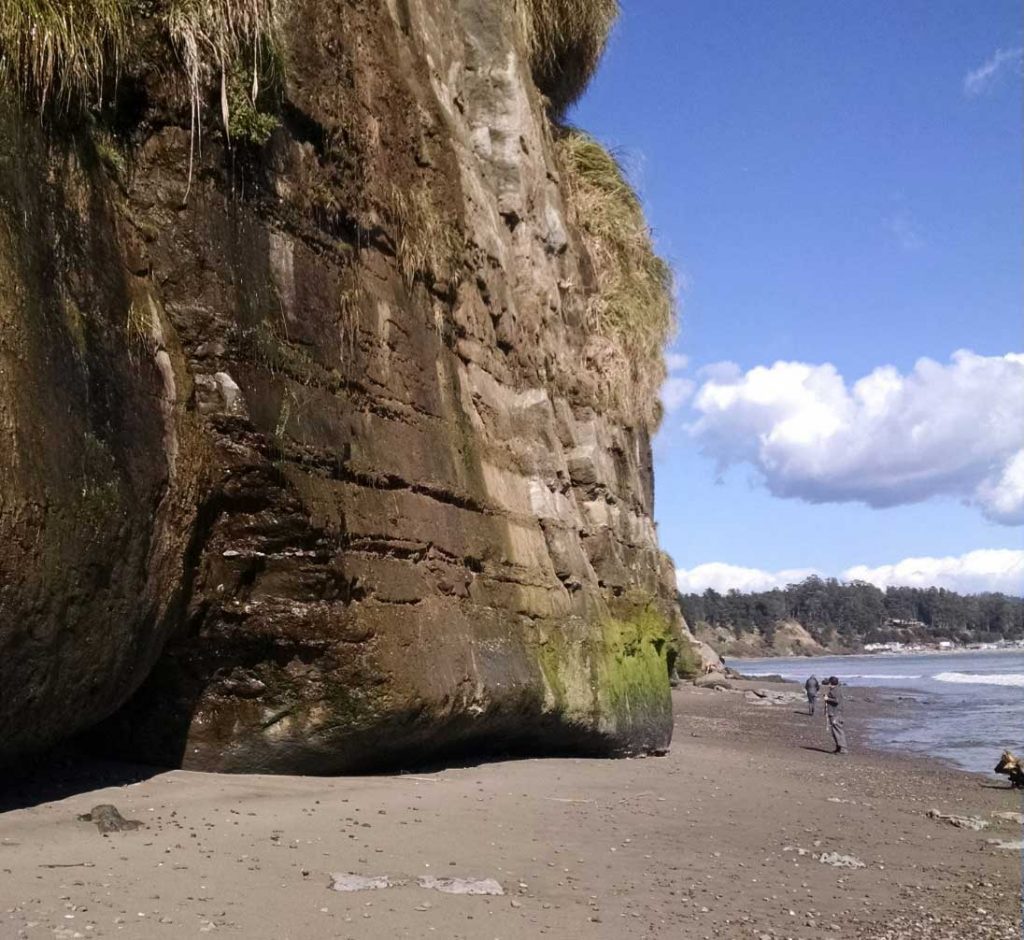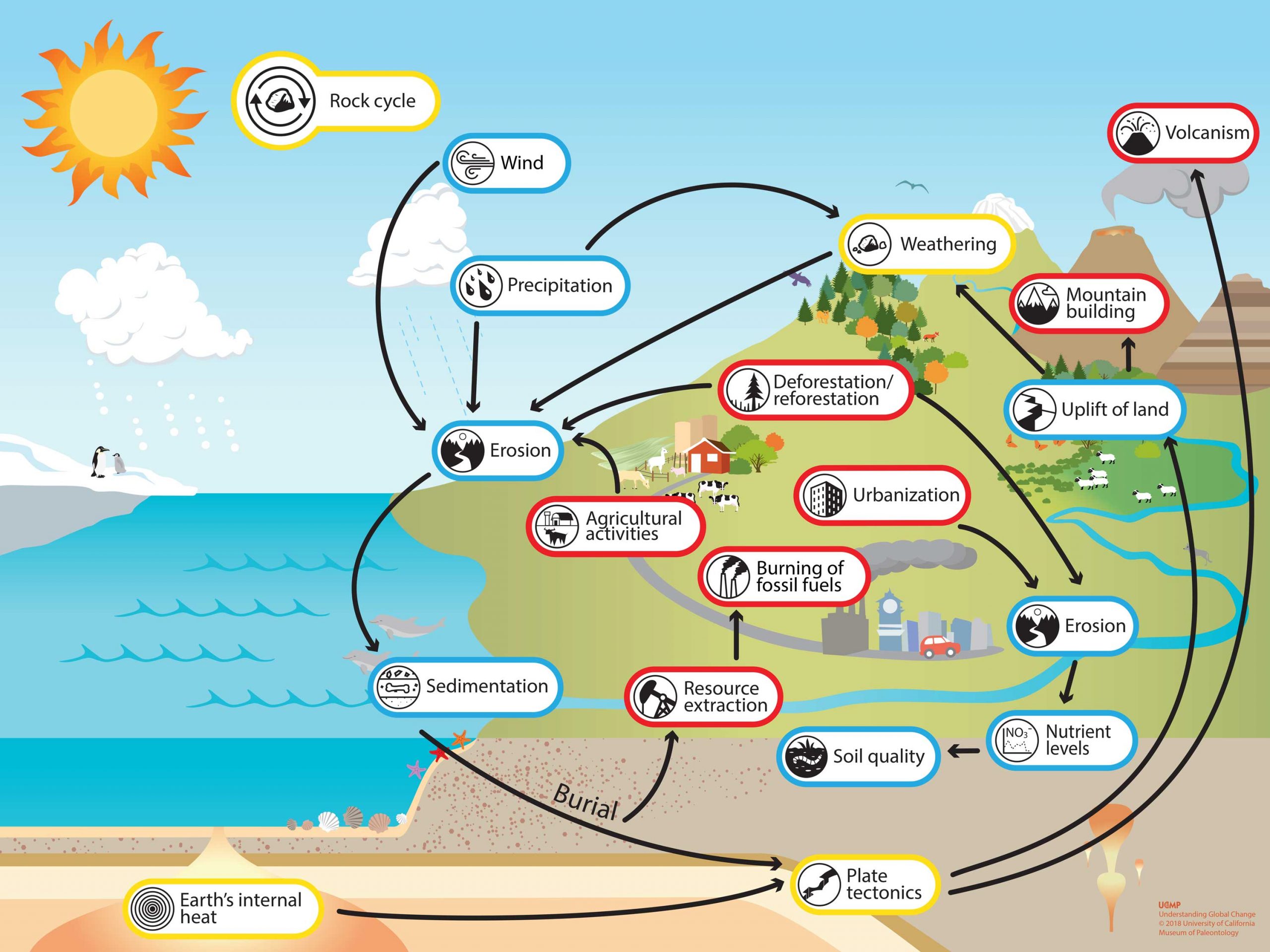The three main rock types are igneous, sedimentary, and metamorphic. Rockscapes.net helps you understand how these rocks form and how to use them to enhance your landscape. By choosing the right rocks, you can create stunning outdoor spaces that reflect your personal style. Delve into our guide and explore various rock formations, landscape design, and natural stone.
Table of Contents
- What Are The Three Main Rock Types?
- What Are Igneous Rocks?
- What Are Sedimentary Rocks?
- What Are Metamorphic Rocks?
- How Does The Rock Cycle Work?
- What Factors Affect The Rock Cycle?
- How Do Human Activities Impact The Rock Cycle?
- What Should Be Considered When Choosing Rocks For Your Landscape?
- FAQ About The Three Main Rock Types
- Ready To Transform Your Landscape?
1. What Are The Three Main Rock Types?
The three main rock types are igneous, sedimentary, and metamorphic, each formed through distinct geological processes. These rock types play a crucial role in shaping landscapes and are widely used in various construction and landscaping applications. Understanding their formation, characteristics, and uses can significantly enhance your landscaping projects.
2. What Are Igneous Rocks?
Igneous rocks, derived from the Latin word “igneus” meaning fire, are one of the primary types of rocks that constitute the Earth’s crust. They are formed through the cooling and solidification of magma or lava. Their unique formation process gives them distinct characteristics and a wide range of uses.
2.1. How Do Igneous Rocks Form?
Igneous rocks form in two primary ways:
-
Intrusive Igneous Rocks: These rocks form when magma cools slowly beneath the Earth’s surface. The slow cooling process allows large crystals to form, resulting in a coarse-grained texture. Granite is a classic example of an intrusive igneous rock.
-
Extrusive Igneous Rocks: These rocks form when lava cools quickly on the Earth’s surface. The rapid cooling process results in small or no crystals, giving the rock a fine-grained or glassy texture. Basalt and obsidian are common examples of extrusive igneous rocks.
According to research from Arizona State University’s School of Earth and Space Exploration, in July 2023, the cooling rate significantly impacts the crystal size and overall texture of igneous rocks.
2.2. What Are The Characteristics Of Igneous Rocks?
Igneous rocks exhibit several distinct characteristics:
- Texture: Igneous rocks can have a coarse-grained texture (phaneritic) if they cooled slowly or a fine-grained texture (aphanitic) if they cooled quickly. Some may even have a glassy texture (vitreous) if the cooling was extremely rapid.
- Mineral Composition: The mineral composition varies depending on the source magma. Common minerals found in igneous rocks include quartz, feldspar, mica, and olivine.
- Color: The color of igneous rocks can range from light (felsic) to dark (mafic), depending on the mineral content. Felsic rocks, like granite, are light in color due to high silica content, while mafic rocks, like basalt, are dark due to high magnesium and iron content.
- Density: Igneous rocks are generally dense and hard, making them durable and resistant to weathering.
2.3. What Are Some Common Examples Of Igneous Rocks?
Several types of igneous rocks are commonly used in construction and landscaping:
- Granite: A coarse-grained, intrusive igneous rock composed mainly of quartz, feldspar, and mica. It is known for its durability and is often used for countertops, paving stones, and decorative stones.
 Granite rock used in landscaping
Granite rock used in landscaping
-
Basalt: A fine-grained, extrusive igneous rock composed mainly of plagioclase and pyroxene. It is commonly used for paving, retaining walls, and as a base material for construction due to its hardness and resistance to weathering.
-
Obsidian: A glassy, extrusive igneous rock formed from rapidly cooled lava. It has a smooth, conchoidal fracture and is often used for decorative purposes.
-
Pumice: A light-colored, porous, extrusive igneous rock formed during explosive volcanic eruptions. It is used in landscaping as a soil amendment to improve drainage and aeration.
2.4. How Are Igneous Rocks Used In Landscaping?
Igneous rocks are versatile materials in landscaping:
- Decorative Stones: Granite and other attractive igneous rocks are used to create visually appealing features in gardens and landscapes.
- Pathways and Paving: Basalt and granite are excellent choices for creating durable and attractive pathways and paved areas.
- Retaining Walls: The strength and durability of igneous rocks make them ideal for constructing retaining walls.
- Water Features: Igneous rocks can be used to create natural-looking water features such as waterfalls and ponds.
- Soil Amendment: Pumice is used to improve soil drainage and aeration in gardens.
By incorporating igneous rocks into your landscape, you can add both beauty and functionality to your outdoor spaces.
3. What Are Sedimentary Rocks?
Sedimentary rocks are formed from the accumulation and cementation of sediments, which are fragments of other rocks, minerals, and organic materials. These rocks provide valuable insights into Earth’s history and are widely used in construction and landscaping.
3.1. How Do Sedimentary Rocks Form?
Sedimentary rocks form through several stages:
- Weathering and Erosion: Rocks are broken down into smaller fragments through weathering (physical and chemical breakdown) and erosion (transport of weathered material).
- Transportation: Sediments are transported by water, wind, ice, or gravity to a depositional environment.
- Deposition: Sediments accumulate in layers in areas such as riverbeds, lakes, and oceans.
- Compaction: The weight of overlying sediments compresses the lower layers, reducing pore space.
- Cementation: Minerals precipitate from solution and bind the sediment grains together, forming solid rock.
3.2. What Are The Characteristics Of Sedimentary Rocks?
Sedimentary rocks have several distinctive characteristics:
- Layering (Stratification): Sedimentary rocks often exhibit distinct layers or beds, reflecting changes in sediment deposition over time.
- Fossils: Sedimentary rocks frequently contain fossils of plants and animals, providing valuable information about past life and environments.
- Texture: The texture of sedimentary rocks depends on the size and shape of the sediment grains. They can be coarse-grained (e.g., conglomerate), medium-grained (e.g., sandstone), or fine-grained (e.g., shale).
- Composition: The composition of sedimentary rocks varies depending on the source of the sediments. Common components include quartz, feldspar, clay minerals, and carbonate minerals.
- Porosity and Permeability: Sedimentary rocks can be porous (containing open spaces) and permeable (allowing fluids to pass through), making them important reservoirs for groundwater and petroleum.
3.3. What Are Some Common Examples Of Sedimentary Rocks?
Several types of sedimentary rocks are commonly used in construction and landscaping:
- Sandstone: A medium-grained sedimentary rock composed mainly of quartz grains. It is commonly used for paving, wall construction, and decorative stones due to its durability and attractive appearance.
 Sedimentary rocks along the coast
Sedimentary rocks along the coast
- Limestone: A sedimentary rock composed mainly of calcium carbonate (calcite). It is used for building construction, paving, and as a source of lime for cement production.
- Shale: A fine-grained sedimentary rock composed mainly of clay minerals. It is used in the production of bricks, tiles, and as a component of some types of cement.
- Conglomerate: A coarse-grained sedimentary rock composed of rounded gravel-sized fragments cemented together. It can be used for decorative purposes in landscaping.
3.4. How Are Sedimentary Rocks Used In Landscaping?
Sedimentary rocks offer a range of landscaping applications:
- Paving and Walkways: Sandstone and limestone are popular choices for creating attractive and durable paving and walkways.
- Wall Construction: Sandstone and limestone are used to build retaining walls, garden walls, and other landscape structures.
- Decorative Stones: Various sedimentary rocks can be used to add texture and visual interest to gardens and landscapes.
- Water Features: Sedimentary rocks can be incorporated into water features such as ponds, streams, and waterfalls.
- Garden Borders: Smaller sedimentary rocks can be used to create borders around flower beds and gardens.
By utilizing sedimentary rocks, you can create unique and visually appealing landscapes that blend harmoniously with the natural environment.
4. What Are Metamorphic Rocks?
Metamorphic rocks are formed when existing rocks (igneous, sedimentary, or other metamorphic rocks) are transformed by heat, pressure, or chemical activity. The process of metamorphism alters the mineral composition and texture of the original rock, creating new and unique rock types.
4.1. How Do Metamorphic Rocks Form?
Metamorphic rocks form through a process called metamorphism, which occurs under the following conditions:
- Heat: High temperatures can cause minerals to recrystallize and form new minerals.
- Pressure: High pressure can cause rocks to become denser and more compact, often leading to the alignment of minerals.
- Chemical Activity: The presence of chemically active fluids can alter the mineral composition of rocks.
There are two main types of metamorphism:
- Regional Metamorphism: Occurs over large areas due to tectonic forces, resulting in the formation of metamorphic rocks such as gneiss and schist.
- Contact Metamorphism: Occurs locally around igneous intrusions, resulting in the formation of metamorphic rocks such as marble and quartzite.
4.2. What Are The Characteristics Of Metamorphic Rocks?
Metamorphic rocks exhibit several key characteristics:
- Foliation: Many metamorphic rocks have a layered or banded appearance due to the alignment of minerals under pressure. This is known as foliation and is common in rocks like schist and gneiss.
- Recrystallization: Metamorphism can cause minerals to recrystallize, resulting in larger, more uniform crystals.
- Increased Density: Metamorphic rocks are often denser than their parent rocks due to the compaction caused by high pressure.
- New Mineral Formation: Metamorphism can lead to the formation of new minerals that are stable under the high-temperature and high-pressure conditions.
4.3. What Are Some Common Examples Of Metamorphic Rocks?
Several types of metamorphic rocks are commonly used in construction and landscaping:
- Marble: A metamorphic rock formed from limestone or dolostone. It is known for its beauty and is used for sculptures, countertops, and decorative stones.
 Metamorphic Rocks in Death Valley
Metamorphic Rocks in Death Valley
- Quartzite: A metamorphic rock formed from sandstone. It is very hard and resistant to weathering, making it suitable for paving, wall construction, and decorative stones.
- Slate: A fine-grained, foliated metamorphic rock formed from shale. It is commonly used for roofing, flooring, and paving due to its durability and ability to be split into thin sheets.
- Gneiss: A coarse-grained, foliated metamorphic rock with distinct banding. It is used for wall construction, paving, and decorative purposes.
4.4. How Are Metamorphic Rocks Used In Landscaping?
Metamorphic rocks offer a variety of uses in landscaping:
- Paving and Walkways: Slate and quartzite are excellent choices for creating durable and attractive paving and walkways.
- Wall Construction: Gneiss and quartzite are used to build retaining walls, garden walls, and other landscape structures.
- Decorative Stones: Marble and other attractive metamorphic rocks are used to add visual interest to gardens and landscapes.
- Water Features: Metamorphic rocks can be incorporated into water features such as ponds, streams, and waterfalls.
- Sculptures: Marble is a popular choice for creating sculptures and other artistic features in landscapes.
By incorporating metamorphic rocks into your landscape designs, you can create stunning and durable outdoor spaces that showcase the beauty of natural stone.
5. How Does The Rock Cycle Work?
The rock cycle is a fundamental concept in geology that describes the continuous transformation of rocks from one type to another. This cycle involves various processes, including weathering, erosion, sedimentation, metamorphism, and melting.
Here is how the rock cycle works:
- Igneous Rocks: Formed from the cooling and solidification of magma or lava. These rocks can be uplifted and exposed at the Earth’s surface.
- Weathering and Erosion: Igneous rocks are broken down into smaller fragments through weathering and erosion.
- Sedimentation: The weathered sediments are transported and deposited in layers.
- Sedimentary Rocks: Over time, the sediments are compacted and cemented together to form sedimentary rocks.
- Metamorphism: Sedimentary rocks can be subjected to high heat and pressure, transforming them into metamorphic rocks.
- Melting: Metamorphic rocks can melt under extreme temperatures, forming magma.
- Repeat: The magma can then cool and solidify, starting the cycle again with the formation of igneous rocks.
The rock cycle is a dynamic process driven by the Earth’s internal heat and external forces such as weathering and erosion.
6. What Factors Affect The Rock Cycle?
Several factors influence the rock cycle, including:
- Earth’s Internal Heat: Drives volcanic activity and metamorphism, leading to the formation of igneous and metamorphic rocks.
- Tectonic Processes: Uplift and mountain building expose rocks to weathering and erosion.
- Weathering and Erosion: Break down rocks into sediments, which are then transported and deposited.
- Climate: Affects the rate of weathering and erosion, influencing the formation of sedimentary rocks.
- Water Cycle: Transports sediments and facilitates chemical weathering.
These factors interact in complex ways to drive the rock cycle and shape the Earth’s surface.
7. How Do Human Activities Impact The Rock Cycle?
Human activities can significantly impact the rock cycle in various ways:
- Extraction of Rocks and Minerals: Mining and quarrying remove rocks from the Earth’s crust, disrupting natural processes and increasing erosion.
- Burning of Fossil Fuels: Releases pollutants into the atmosphere, contributing to acid rain and increasing chemical weathering.
- Urbanization: Paving land with concrete increases water runoff and erosion.
- Deforestation: Removes vegetation, destabilizing soils and increasing erosion rates.
- Damming Rivers: Alters sedimentation patterns and affects soil quality.
According to research from the United States Geological Survey (USGS), human activities have accelerated erosion rates and altered natural sedimentation patterns, impacting the rock cycle and ecosystem health.
 The Earth System
The Earth System
8. What Should Be Considered When Choosing Rocks For Your Landscape?
Choosing the right rocks for your landscape involves several considerations:
- Type of Rock: Select rocks that are appropriate for the intended use, considering their durability, texture, and appearance.
- Size and Shape: Choose rocks that are the right size and shape for the specific application, such as paving, wall construction, or decorative stones.
- Color and Texture: Select rocks that complement the overall design of your landscape.
- Availability and Cost: Consider the availability and cost of different types of rocks in your area.
- Environmental Impact: Choose rocks from sustainable sources to minimize environmental impact.
- Local Climate: Consider how the rock will withstand local weather conditions, such as temperature fluctuations and precipitation. For example, in Arizona, choosing rocks that can withstand extreme heat and occasional heavy rains is crucial.
By carefully considering these factors, you can choose rocks that will enhance the beauty and functionality of your landscape for years to come.
9. FAQ About The Three Main Rock Types
Here are some frequently asked questions about the three main rock types:
- What are the three main types of rocks? The three main types of rocks are igneous, sedimentary, and metamorphic, each formed through distinct geological processes.
- How are igneous rocks formed? Igneous rocks are formed from the cooling and solidification of magma or lava, either beneath the Earth’s surface (intrusive) or on the surface (extrusive).
- What are some examples of sedimentary rocks? Common examples of sedimentary rocks include sandstone, limestone, shale, and conglomerate, each formed from the accumulation and cementation of sediments.
- How do metamorphic rocks form? Metamorphic rocks form when existing rocks are transformed by heat, pressure, or chemical activity, altering their mineral composition and texture.
- What is the rock cycle? The rock cycle is a continuous process in which rocks are transformed from one type to another through weathering, erosion, sedimentation, metamorphism, and melting.
- Why is understanding rock types important for landscaping? Understanding rock types helps you choose the right materials for different landscaping applications, ensuring durability, aesthetics, and functionality.
- Can I use any type of rock in water features? It’s best to use rocks that are resistant to weathering and don’t contain minerals that can leach into the water, such as certain types of sedimentary rocks with high iron content.
- How does climate affect the choice of rocks for landscaping? Climate affects the rate of weathering and erosion, so it’s important to choose rocks that can withstand local weather conditions, such as temperature fluctuations, precipitation, and freeze-thaw cycles.
- Where can I find sustainable sources of rocks for landscaping? Look for local quarries and suppliers that follow sustainable practices, such as minimizing waste and reducing environmental impact.
- How do human activities impact the rock cycle? Human activities such as mining, urbanization, and deforestation can disrupt natural processes, accelerate erosion rates, and alter sedimentation patterns, impacting the rock cycle and ecosystem health.
10. Ready To Transform Your Landscape?
Ready to bring your landscaping dreams to life? At Rockscapes.net, we offer a wide range of high-quality rocks and expert advice to help you create the perfect outdoor space.
- Explore our stunning gallery of landscape designs for inspiration.
- Discover the unique characteristics and applications of different rock types.
- Get step-by-step guidance on how to incorporate rocks into your landscape projects.
Don’t wait any longer to create the landscape you’ve always wanted. Visit Rockscapes.net today and let our team of experts help you choose the perfect rocks for your project.
Contact us:
Address: 1151 S Forest Ave, Tempe, AZ 85281, United States
Phone: +1 (480) 965-9011
Website: Rockscapes.net
Let rockscapes.net be your partner in creating beautiful and sustainable landscapes that you’ll enjoy for years to come.

